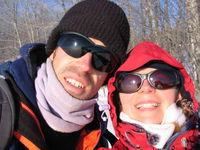Advertisement

 Rano Raraku
Rano Raraku
The quarry. Where the partially carved (basalt) Moai were slowly moved down the hill to other places on the island. The eye sockets and eyes were added later as were more detailed facial features of the person being honoured.Iorana! (Rapa Nui for Hello)
Off we flew to one of the most remote islands on the planet...Isla Pascua (Easter Island). And we were hosted by the lovely town of Hanga Roa.
Far flung Easter Island sits about 3700 km from its Motherland in the middle of the Pacific Ocean - it is one of the most isolated inhabited places on Earth.
They say that timing is everything. We arrived on the island at a very interesting time, indeed (politically!) The indigenous Rapa Nui people have kicked the Chilean National Park workers out of office and have taken over operations of the historical sites. (And presently, Chileans are not allowed at the sites.)
Financially, it was great for us as we didn’t have to pay the USD 60 each for entrance fee to the island. Some changes of the sites were occurring on a daily basis, like new boundaries where you could and could not walk. So even our tour guide (who has been doing tours for years) had to pay close attention to the new rules placed on the grounds. With the lack of funds to maintain the national monuments, the system has already started to

 Ahu Tongariki
Ahu Tongariki
The standing Moai, only one sports a pukau (a topknot or hair piece).show signs of falling apart. We hope that the issue is resolved soon!
Paul was our host and guide. He has been on the island since the sixties, working as a guide and archaeologist, trying to unravel the mysteries surrounding the Moai. He was personally involved in some of the early efforts of restoration of the Moai and Ahu. So his stories and anecdotes were genuine and engaging as he showed us all around the island. He talked in depth about his personal experiences and shared much of his private life with us. We stayed at his lodge for our entire time - a beautiful wooden building, surrounded by trees. (The first wooden building that we stayed at for this entire trip vs. the concrete or adobe houses we had become accustomed to.)
Why were the Moai carved and then hauled across the island? Why were they all knocked over? Like many ancient cultures, little is known about the Rapi Nui culture and their monoliths. There is much debate about why these human-like figures watched over the island. But we will likely never know.
The Moai and their Ahu are all over Easter Island, strategically placed many

 Rano Kau
Rano Kau
The crater and lake.moons ago. With a single exception, all of the Moai are on the coast facing inwards (one Moai was in the interior of the island). And all but one of the Moai are carved in a standing-straight position. The one exception is a Moai with legs and the knees are bent in a kneeling position. What was the significance of this? No one really knows. Over the years, many Moai have been reassembled and restored, but some of the sites are as they were found, face down with their necks broken.
Near the fall of the Moai culture, a new cult of bird worshiping evolved on Easter Island. The bird-man culture was based at the ceremonial village of Orongo at the crater rim of Rano Kao volcano. It is theorized that the people of this new culture pushed over and destroyed all the standing stones. It is also theorized that both cultures could have simultaneously existed. The debate continues...
Hanga Roa is the only town on the island and its sub-tropical streets are lined with seafood eateries and other lovely flavours. We treated ourselves to a very tasty seafood meal at a local restaurant on the edge of
the town, overlooking the Pacific. We had the full seafood platter with king prawn, lobster, crab, squid, octopus, scallops, and a wonderful plate of ceviche (raw slices of tuna marinated in lime juice and spices). The locals are so friendly and the vibe in town is always cheerful and relaxing.
It was a very peaceful stay on Isla Pascua. We could appreciate the remoteness when we would here Paul mention that "last week there was no cheese on the island". Or, "I'm glad you had a great seafood dinner, as last month there was no tuna".
The humid air was welcoming, after spending so much time in the dry desert climate. The fresh breeze, the lush green, the restless sea, and the tranquillity were like a lullaby to our weary, travelling souls . The island certainly has its ecological issues. But it is a fabulous and unique place to visit. It stimulates much curiosity and reverence. We feel blessed to have seen it, knowing how fast the stones are eroding. And knowing how swiftly the history is changing...
Iorana,
Dave and Theresa...
Advertisement
Tot: 0.225s; Tpl: 0.014s; cc: 28; qc: 165; dbt: 0.1239s; 1; m:domysql w:travelblog (10.17.0.13); sld: 1;
; mem: 1.5mb






























Doug
non-member comment
Incredible
GREAT pix and thanks for sharing your visit to this very remote, fascinating and mysterious island. I am beginning to think you two are on a mission to visit everyplace on earth. You are off to a great start.